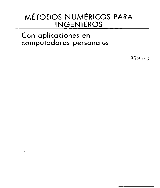


For our case, v(0) = 0, so the final solution is v= mg 1 e ( c '/ m )t c' Where the first term to the right of the equal sign is the general solution and the second is the particular solution. (1) to give V= mg / c' mg / c' v ( 0) + s s + c' / m s + c' / mĪpplying inverse Laplace transforms yields v= or mg mg ( c '/ m )t e + v ( 0) e ( c ' / m ) t c' c' (2), and the result can be substituted back into Eq. These results can be substituted into Eq. G A B = + s ( s + c ' / m) s s + c ' / mg A( s + c' / m) + Bs = s ( s + c ' / m) s ( s + c ' / m)Įquating like terms in the numerators yieldsA+ B=0 g= c' A m The first term to the right of the equal sign can be evaluated by a partial fraction expansion, Thus, halving the step size approximately halves the error.1.4 (a) The force balance isĭv c' =g v dt m Applying Laplace transforms, sV v(0) = Solve for V= g v ( 0) + s ( s + c ' / m) s + c ' / m(1)

The error versus step size can be plotted as2.0%ġ.0% relative error 0.0% 0 0.5 1 1.5 2 2.5 Where the relative error is calculated with

If v = 0 at t = 0, then because tanh1(0) = 0, the constant of integration C = 0 and the solution is1 v c tanh 1 = d t a a m This result can then be rearranged to yieldġ.2 This is a transient computation. Therefore, the integration yields1 v c tanh 1 = d t + C a a m M dv = a2 v2 c d dt Integrate by separation of variables,Ī 2 v 2 = m dtA table of integrals can be consulted to find that M dv m = g v2 c d dt c dDefine a = mg / c d Applied Numerical MethodsWith MATLAB for Engineers and ScientistsĬHAPTER 11.1 You are given the following differential equation with the initial condition, v(t = 0) = 0,Ĭ dv = g d v2 dt mMultiply both sides by m/cd


 0 kommentar(er)
0 kommentar(er)
